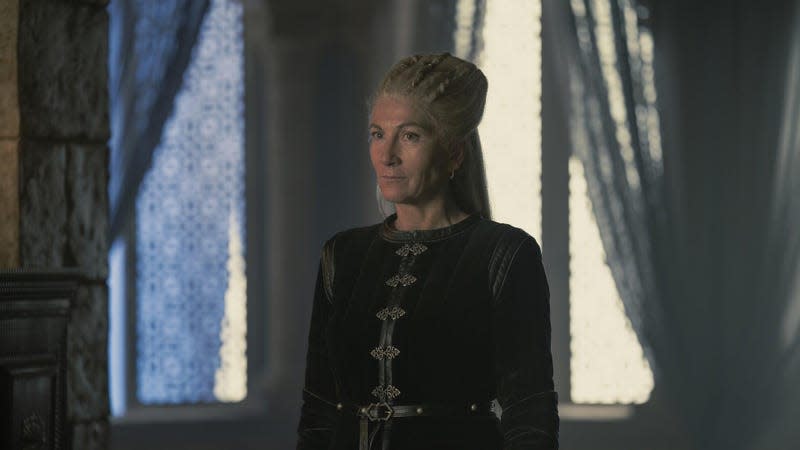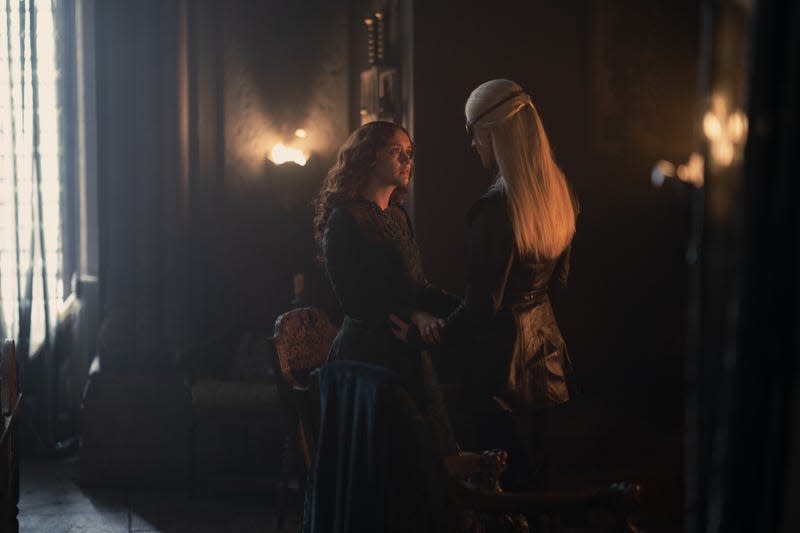House Of The Dragon director Clare Kilner walks us through last night’s big dragon moment

- Oops!Something went wrong.Please try again later.
- Oops!Something went wrong.Please try again later.
There’ve been some great dragon moments in the first season of House Of The Dragon, but the one at the climax of episode nine, “The Green Council,” ranks among the best dragon entrances so far. It capped an eventful episode in which the Hightowers were scrambling to get Prince Aegon on the Iron Throne before Princess Rhaenyra even knows her father is dead.
The A.V. Club talked with Clare Kilner, the director of “The Green Council,” as well as episodes four and five. She walked us through how episode nine’s massive effect was achieved, and revealed that one of the episode’s most devastating lines was improvised by the actor during rehearsals. We also asked about how she brings her personal perspective to the franchise, which hasn’t historically had many women behind the camera.
Read more
As <em>Halloween Ends</em>, let's rank the best performances of Jamie Lee Curtis
The 20 biggest game-changing moments from <em>The Walking Dead</em>
Halloween costume ideas to suit every pop culture fan for 2022
The A.V. Club: Before we begin, I have to ask—what is your drink of choice?
Clare Kilner: [Laughs] Mine is the skinny margarita with a dash of dragon breath.
AVC: Okay, now that that’s out of the way, congratulations on this episode. It really kicked things into high gear.
CK: It’s so absolutely enormous. And beautifully written, I hasten to add, by Sara Hess. I was quite nervous. But in the end, I wasn’t because I had such a brilliant team of people around me, all supportive of my creative vision. And my creative vision obviously came from Sara’s script, which had so much depth to it.
AVC: Obviously there’s a lot going on in this episode, but could you walk us through that massive scene at the end, where Rhaenys crashes the coronation on dragonback?
CK: It took many, many people, a huge team of people to pull this off. I sort of start with, what’s at the heart of the scene? How do we illustrate what’s going in the hearts and minds of all of these people visually? And [D.P. Alejandro Martinez] and I, the way we work is that we go into the set and we actually play the scene out. We are, you know, terrible actors [laughs]. But we say the words, so we hear them out loud and we start thinking about, for example, “You know what? If we had to shoot the scene in one, what would it be?”
So we start just talking about it and drawing up a short list, then we start storyboarding it. Then we had this incredible opportunity to have a virtual reality scenario where we actually put on these sort of—I mean, I’m not a gamer, so forgive me if I use the wrong words—but these sort of like headsets and we navigate around the dragon as it would be in the CGI world. And we can put different lenses on so we can see where each shot would be. And literally we’re walking around the room looking completely weird with these headsets on. But it’s an incredible gift to be able to do that, to plan things beforehand.
So then this is when Nick Hextall Smith, the first A.D., becomes heavily involved. He is absolutely amazing. And he pushed me to really work out every single detail and to clarify every single detail because we have to work out how to shoot this in so many layers. So, for example, we shot, you know, Rhaenyra heading towards the dragon pit in Cáceres with Spanish supporting artists. Then we shot her on the stairs that Jim Clay had built in the studios in Leavesden with British supporting artists. And then we had the actual set, which was meant to be the size of a football pitch. But of course the studio is only a third of that size. So when we’re shooting crowd scenes, we have to shoot sort of 100 people, move those out, shoot it, and then put up a blue screen, shoot another 100 people against a blue screen, move those and shoot another hundred people. And then all of these people get composited together.
And then we have the people, like everyone coming in. We have to shoot that repeated times. And then they have to look at a blue screen, because obviously the royal dais is much further away than it actually was. So they all have to act against me. And, you know, I’m telling them what everyone else is doing on the other side as they’re coming in. Literally, my voice was hoarse, because when the dragon comes out, I’m like, “And the ground opens up! And something comes through! And there’s this huge roar!” So it’s quite amazing. It was fun and exhausting.

Olivia Cooke, Ewan Mitchell
AVC: Did you have to make any compromises on the day of the shoot because it was so complicated?
CK: Aegon was meant to come in on horseback, but we realized there was no way we could add horses into this crazy situation already. So I started watching military processions and things and I saw, you know, these arches of swords. And I just love the sounds swords make as they go down. I’m really into it. And so we created this sort of L shape that Aegon had to walk through. And eventually I loved the image that he would see his mother through the swords and he had to walk up to Mummy as he’s, you know, heading up. Yeah.
AVC: This world can feel so expansive with the big set pieces and complicated effects, and yet it also has those small, emotional scenes between two characters in a room.
CK: There was an interesting thing that happened when Alicent and Aegon were in the wheelhouse, because there’s so much silence there. And I was like, “What is going on in this silence?” As they’re going to this coronation there’s so much underneath the words. And I love the fact that it was written sparsely. And so we did a little improvisation like, “What’s going on? What do you want to say to her? What do you want to say to him? What would you say if you could?” And we did a little improvisation and then Tom [Glynn-Carney] ended it with, “Do you love me?” And that wasn’t in the script. And of course, then we did the scene and he added it in the end. And that’s what that whole scene is about. And it was so powerful. And you just know those moments. It’s like, “Oh, this is gold.”
AVC: It’s nice to see women behind the scenes on this show, because there weren’t any women directors on Game Of Thrones. Do you feel like you bring a different perspective to directing that we might not otherwise get? I’m thinking in particular of the brothel scene in episode four, which might have played differently from a man’s point of view.
CK: I mean, a hundred percent. I do see the difference, and I was very aware of that responsibility. But also I have a desire in myself to shoot things in a different way. I had time to think about it and I had to think long and hard. I’ve been in an industry for a while now. You know, I’m not 20, but I’ve grown up watching films and TV my whole life. And, you know, I’m a huge fan of it all. But I hadn’t realized when I was younger that I was growing up watching sex from the male gaze. I just thought that was sex, you know? And so I had to think, “Oh gosh, what is the female gaze?” And I kept on thinking of things with a male gaze. So I had to really think about, “Okay, what is my gaze? Let’s stop thinking about female and male gaze. Gosh, what do I think about this story and how would I like to see it told?”
And everything about directing is that it starts complicated and it boils down to something simple. The answer is genuinely, usually simple, but it takes a while to get there. And so that’s what I did. And I talked to the actors and I’m like, “How do they feel?” And I love collaborating with the actors, because they are always so intelligent and really are the keeper of the point of view of their character. So, you know, I don’t want to tell them what to do. I want to work with them so they feel like happy and confident in the story that putting out there because there is such a responsibility. This goes out far and wide.

